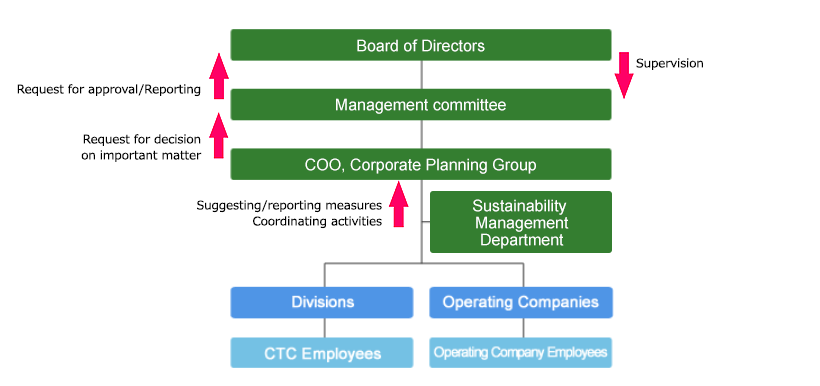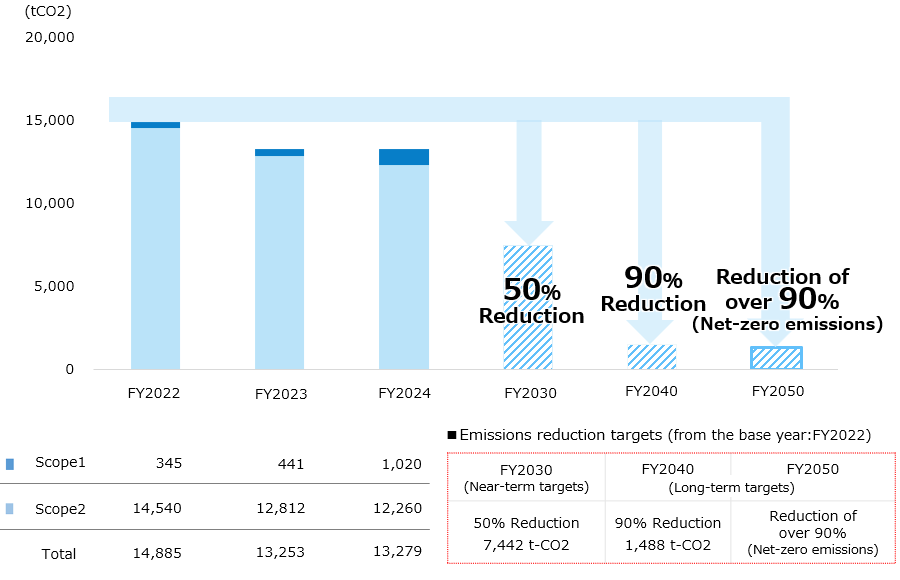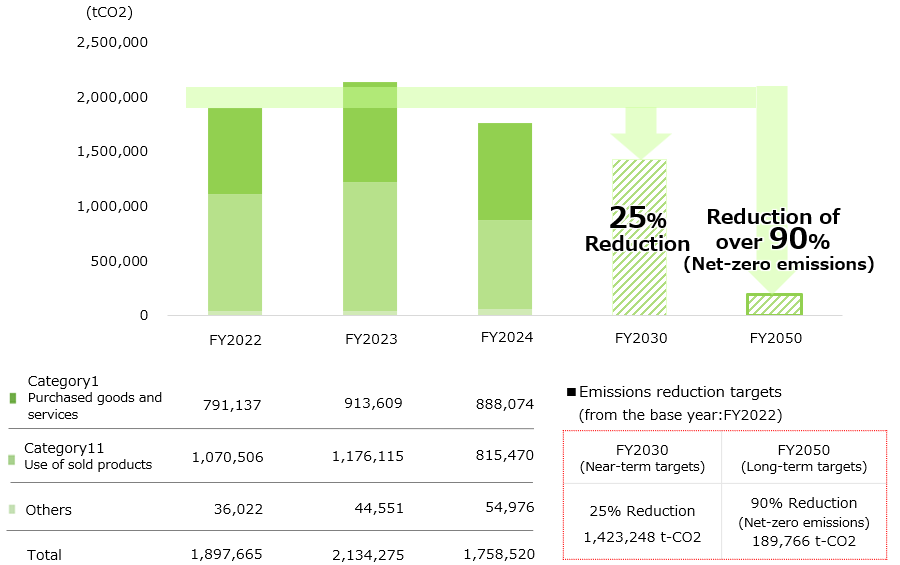Response to climate change
Disclosures based on the TCFD recommendations
Recent years are seeing increasingly serious impacts from climate change, including weather-related disasters. Under these circumstances, there are growing expectations for IT as a tool for overcoming serious global environmental crises. In this respect, we believe that the CTC Group has significant roles and responsibilities to fulfill. We have identified "Contribute to addressing climate change" as one of the items of materiality (material issues) that were renewed in April 2021. Moreover, in April 2022, we expressed support for the Task Force on Climate-related Financial Disclosures (TCFD). We will work to realize a decarbonized society with our technologies and skills and ensure appropriate disclosures in accordance with the TCFD recommendations, aiming to build a sustainable society rich in dreams.

Governance
To address climate change, we have created a structure for promoting sustainability, headed by the President & CEO.Decisions on and approvals of important matters are made by the Management Committee and the Board of Directors after considering the opinions gathered from a wide range of employees and consulting with relevant divisions.We have also established a structure under which activities related to climate change are reported regularly to the Board of Directors for their supervision.
Major important matters
Matters related to climate change risks and opportunities, important guidelines and measures related to climate change, progress in medium- and long-term environmental targets including CO2 reduction, and others
Role and frequency of each meeting body
| Category | Roles | Frequency of meetings |
|---|---|---|
| Board of Directors | Supervising climate change countermeasures | About twice a year |
| President & CEO (Management Committee) | Determining important matters associated with climate change countermeasures | About twice a year |
CTC Group's structure for promoting sustainability
We promote action against climate change under the following structure.

Strategies
Using scenarios* disclosed by an international institution and other entities, we studied how climate change affects our businesses. We identified the direct impacts of climate change on our businesses, including our supply chain (domestic businesses), as well as changes in policy trends and other impacts on our business activities, income, and other aspects. We then analyzed the financial impacts of the identified opportunities and risks expected in 2030 and 2050, both qualitatively and quantitatively by using the 4℃ and 1.5℃ scenarios, and summarized our policies for countermeasures. An outline of the results is as follows.
We position climate change countermeasures as opportunities for medium- to long-term growth and we are proactively expanding the green transformation (GX) business toward a decarbonized society, as a means to address social issues and achieve sustainable growth.
- *Reference: Intergovernmental Panel on Climate Change (IPCC) RCP8.5 / RCP2.6, International Energy Agency (IEA) STEPS/NZE2050
| Opportunities related to climate change | Magnitude of impact*2 | Action policies | |||||
|---|---|---|---|---|---|---|---|
| Category | Details | Length of time required before actualization*1 | 4℃ scenario | 1.5℃ scenario | |||
| 2030 | 2050 | 2030 | 2050 | ||||
| Products and services |
|
Short term | Small | Small | Medium | Medium |
|
| Market |
|
Short term | Large | Large | Large | Large |
|
| Climate change risks | Magnitude of impact*2 | Action policies | |||||
|---|---|---|---|---|---|---|---|
| Category | Details | Length of time required before actualization*1 | 4℃ scenario | 1.5℃ scenario | |||
| 2030 | 2050 | 2030 | 2050 | ||||
| Policies and legal restrictions |
|
Medium term | Small | Small | Medium | Medium |
|
| Reputation |
|
Short term | Small | Small | Large | Large |
|
| Physical |
|
Short term | Medium | Medium | Small | Medium |
|
-
*1Length of time required before actualization
Short term: Up to 5 years from now, Medium term: Within 6 to 10 years, Long term: 11 or more years later - *2Magnitude of impact | Small: less than 300 million yen, Medium: from 300 million to less than 2 billion yen, Large: 2 billion yen and more
Initiatives to address opportunities and risks
Examples of initiatives to address opportunities and risks are given below.
Initiatives to address opportunities related to climate change
- Offering a Digital Twin Solution for the GX of the Manufacturing Industry (press release dated September 1, 2023)
We offer a service to reduce GHG emissions and power consumption during production by reproducing the factory environment on the computer to simulate it, and another service that optimizes delivery routes for transportation businesses to reduce GHG emissions from logistics.
https://www.ctc-g.co.jp/company/release/20230901-01619.html - As a GX Solution, CTC Begins Offering Leases with Carbon Credits (press release dated October 10, 2023)
The service involves purchasing carbon credits when concluding a lease agreement for an IT device to offset the GHG emissions from the use of the IT device.
https://www.ctc-g.co.jp/company/release/20231010-01639.html - Strengthening Collaboration with US Company QuesTek to Expand the Materials Informatics Business (press release dated September 21, 2023)
We expand the materials informatics business of exploring new materials using IT. It leads to reduction of costs and environmental impact.
https://www.ctc-g.co.jp/company/release/20230921-01628.html - Launch of Collaboration with LIFULL Agri Loop to Realize a Recycling-oriented Society (press release dated March 26, 2024)
The collaboration started with the goal of creating new business models in the field of agriculture and livestock farming and to realize a recycling-oriented society.
Examples include the validation of the effects of Poop Loop, a catalyst for the conversion of manure into fertilizer, and analysis and verification for carbon credit trading.
https://www.ctc-g.co.jp/company/release/20240326-01713.html - Offering StateEco, a Resource Recycling Platform to Visualize Waste Disposal (press release dated June 27, 2024)
We offer a resource recycling platform to facilitate the recycling of waste into raw materials for products.
https://www.ctc-g.co.jp/company/release/20240627-01761.html
Initiatives to address risks related to climate change
- Support for the Task Force on Climate-related Financial Disclosures (TCFD) and information disclosures
- Revising the 2050 CTC Group Environmental Declaration (greenhouse gas reduction targets)
- Obtaining the Science Based Targets initiative (SBTi)'s certification of near-term targets and net zero targets
- Participation in the GX League
- Continuing to take disaster prevention and mitigation measures related to our business continuity plan (BCP)
- Mitigating risks through the continued utilization of telework
Risk management
We clarify, identify, and assess climate change risks (assess the level of their impacts by using various parameters based on multiple future forecast scenarios). We formulate measures for them under our sustainability promotion structure and in accordance with company-wide risk control methods and TCFD framework.
Further, the Board of Directors supervises this risk control together with other material company-wide risks.
Metrics and targets
Greenhouse gas emissions by volume are the indicator. Our targets are set out in the 2050 CTC Group Environmental Declaration revised in April 2024. The details are shared below.
Greenhouse gas emissions (consolidated)
Scope 1, Scope 2

- * FY2024 Total does not tally with the sum of Scope1 and Scope2 numbers, which are rounded off to nearest whole number.
Scope 3

Third-party assurance has been obtained for the results of greenhouse gas emissions (Scope 1, 2 and 3).
Independent Assurance Report(FY2024)(PDF/1.08MB)
Independent Assurance Report(FY2023)(PDF/1.13MB)
Independent Assurance Report(FY2021, FY2022)(PDF/1.08MB)
